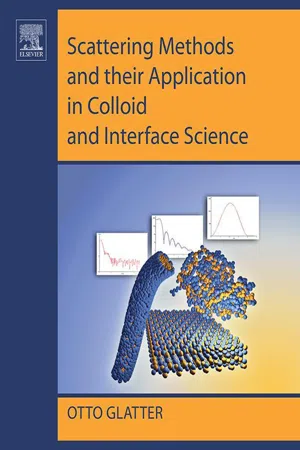
- 404 pages
- English
- ePUB (mobile friendly)
- Available on iOS & Android
Scattering Methods and their Application in Colloid and Interface Science
About this book
Scattering Methods and their Application in Colloid and Interface Science offers an overview of small-angle X-ray and neutron scattering techniques (SAXS & SANS), as well as static and dynamic light scattering (SLS & DLS). These scattering techniques are central to the study of soft matter, such as colloidal dispersions and surfactant self-assembly. The theoretical concepts are followed by an overview of instrumentation and a detailed description of the evaluation techniques in the first part of the book. In the second part, several typical application examples are used to show the strength and limitations of these techniques.- Features the latest input from the world-leading expert with personal experience in all the fields covered (SAXS, SANS, SLS and DLS)- Includes unified notation throughout the book to enhance its readability- Provides—in a single source—scattering theory, evaluation of techniques and a variety of applications
Frequently asked questions
- Essential is ideal for learners and professionals who enjoy exploring a wide range of subjects. Access the Essential Library with 800,000+ trusted titles and best-sellers across business, personal growth, and the humanities. Includes unlimited reading time and Standard Read Aloud voice.
- Complete: Perfect for advanced learners and researchers needing full, unrestricted access. Unlock 1.4M+ books across hundreds of subjects, including academic and specialized titles. The Complete Plan also includes advanced features like Premium Read Aloud and Research Assistant.
Please note we cannot support devices running on iOS 13 and Android 7 or earlier. Learn more about using the app.
Information
Interference, Rayleigh–Debye–Gans Theory
Abstract
Keywords
Interference of Scattered Waves
Table of contents
- Cover image
- Title page
- Table of Contents
- Copyright
- Preface
- Chapter 1. Interference, Rayleigh–Debye–Gans Theory
- Chapter 2. General Theorems and Special Cases
- Chapter 3. The Inverse Scattering Problem
- Chapter 4. Concentration Effects, Interactions
- Chapter 5. Absolute Intensity, SAXS, and SANS
- Chapter 6. Contrast Variation
- Chapter 7. Instrumentation for SAXS and SANS
- Chapter 8. Numerical Methods
- Chapter 9. Static Light Scattering From Small Particles
- Chapter 10. Light Scattering From Large Particles: Lorenz−Mie Theory
- Chapter 11. Dynamic Light Scattering (DLS)
- Chapter 12. Dilute Systems: Practical Aspects—Applications
- Chapter 13. Concentrated, Interacting Systems: Practical Aspects, Applications
- Chapter 14. Glasses, Liquid Crystals, and Gels
- Appendix
- References
- Index